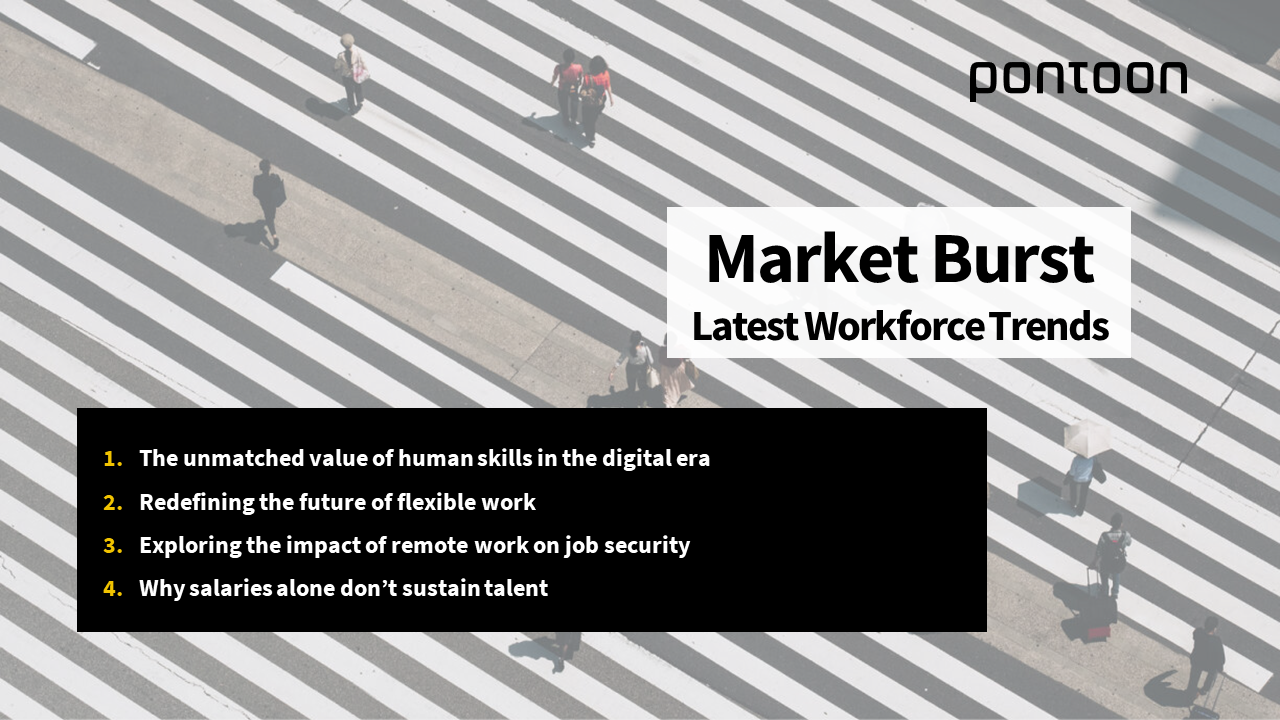Latest workforce trends
Research
.
Explore the workforce trends that continue to drive the labour market. These include redefining the future of flexible work, the impacts of remote work on job security, and the talent insights from our Global Workforce of the Future report.
The unmatched value of human skills in the digital era
The findings from our latest Global Workforce of the Future report highlight the value of human qualities in the new digital reality. A substantial 61% of workers affirm that while AI is an excellent tool for boosting productivity, the indispensable human touch still greatly impacts the workplace, and there are certain skills that cannot be replaced with technology. These include emotional intelligence, empathy and interpersonal skills. Interestingly, the workforce in the tech sector is the most convinced that innately human qualities are more influential than AI at work (67%).
- Incorporate regular coaching sessions tailored to individual strengths and weaknesses. Leadership development initiatives play a pivotal role in nurturing these skills at all levels of the organisation.
- Ensure transparency in communicating skills requirements for future career advancements. Employers should offer clear guidance on the skills and competencies needed to thrive in evolving roles.
- Encourage non-linear career paths. Promoting lateral moves and providing opportunities for diverse experiences can contribute significantly to developing a well-rounded skill set.
Redefining the future of flexible work
The dimensions of work flexibility extend far beyond just the office jobs and hybrid work models. In her thought-provoking conversation at the recent World Economic Forum in Davos, Pontoon’s President, Valerie Beaulieu-James, pointed out that the definition of flexibility can vary amongst workers, and firms must better cater to their unique needs.
For example, while the market is raving about the resistance to return-to-office mandates, frontline workers want to choose their shifts and schedules, as working-from-home was largely unavailable for them from the start. Selecting shifts empowers frontline staff by giving them more control over their work-life balance and outside-of-work commitments. It prevents disrupted routines and conflicts with other personal matters and enhances job satisfaction, increasing productivity and retention rates.
One thing in common for all industries and job types is the need for retraining managers. For many years, manager focus was on time-controlling their workforce’s productivity in environments where they could physically see what their teams were doing. We now need leaders who can navigate flexible ways of approaching work and the new “workplace–worker contract” where the attention shifts from micromanaging time to evaluating outcomes. Fostering a culture of trust and autonomy is crucial in this new dynamic. How can companies support their managers? A few suggestions include:
- Providing comprehensive training programmes that focus on developing skills related to goal-setting, communication, performance evaluation, and feedback.
- Offering one-on-one coaching or mentoring sessions with experienced leaders who have successfully transitioned to an outcome-based management style.
- Ensuring that managers have access to the necessary resources, tools, and technology to effectively manage flexible teams and track outcomes.
- Establishing clear expectations and guidelines for managers regarding performance metrics, time-tracking, goal-setting processes, communication protocols etc.
Exploring the impact of remote work on job security
In 2023, the likelihood of being laid off was 35% higher for full-time remote workers compared to their counterparts based in physical office spaces. This worrying phenomenon stems from the so-called “proximity bias”, where physical presence close to a business leader becomes a source of advantage for on-site workers. So far, it’s been brought up mainly in the context of reduced promotional opportunities for work-from-home staff. However, considering the 2023 job cuts, it became clear that managers tend to reduce the roles of people they don’t have a closer relationship with – the sort of relationship that is easier to develop in-person and on-site. With 85% of workers expressing apprehension about facing layoffs in 2024 and some big players starting job reductions in January, organisations must rethink their strategies to ensure fairer downsizing.
It requires a thoughtful and transparent approach that prioritises equity and empathy. A few critical elements include:
- Establishing clear and objective criteria for selecting workers, considering factors such as performance, skills, and contribution to the organisation, irrespective of work location.
- Communicating the downsizing process openly, providing workers with a comprehensive understanding of the reasons behind the decision and the criteria used for selection.
- Offering outplacement services, such as counselling or job placement assistance, can further soften the impact on affected individuals.
- Encouraging open dialogue and feedback channels to address concerns and gather insights from the workforce.
Why salaries alone don’t sustain talent
According to Pontoon’s data, more workers confirm that they are staying with their current employer compared to previous years – 73% in 2023 vs 61% in 2022. Interestingly, while the top reason to quit is for a better salary (31% of workers), compensation drops to ninth place in reasons to continue employment when workers are happy with their current employer.
While a competitive salary is crucial for initially drawing skilled professionals into an organisation, it alone does not guarantee long-term commitment. Firms must build a robust foundation for retaining top talent and nurturing a resilient and dedicated workforce by focusing on multifaceted elements:
- Career growth is a significant motivator, and workers are more likely to stay with an organisation that invests in their professional development internally. This provides opportunities to expand their skills and explore new areas within the safety of their current stable employment.
- Also, a workplace that emphasises collaboration and encourages positive relationships among team members contributes significantly to worker satisfaction.
- Work-life balance is equally crucial. Firms must evaluate their current priorities and deliverables to identify pockets of overload and better redistribute resources.
Related Post
Explore the top 2024 workforce predictions that will drive talent management this year. These include accelerating implementation of AI, shift to skills-focused hiring, rethinking workplace culture, and the lastest insights ...





